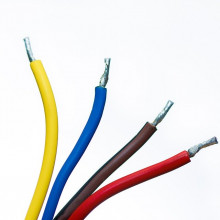How do electrons flow in electric current?
Rakesh got in touch with this question: "Typically when electrons flow for the electric current, do they come out from the atoms and flow as electric current? Is it not true that when electrons come out from atoms light and energy is released? So why don't electric wires change their colours?" Eva Higginbotham got in touch with Dr Ankita Anirban to find out the answer...
In this episode

00:00 - QotW: How do electrons flow in electric current?
QotW: How do electrons flow in electric current?
Rakesh - 'So typically when electrons flow for the electric current, do they come out from the atoms and flow as electric current? Is it not true that when electrons come out from atoms light and energy is released? So why don't electric wires change their colours?'
Eva - I put the question to Dr Ankita Anirban, an expert on electron transport.
Ankita - When you imagine electric current flowing through a wire, think of a mexican wave in a stadium. Each person in the chain moves and contributes to the wave passing through, but nobody actually has to leave their place. Similarly, the electrons are moving and passing on energy to their neighbours which causes a current to flow. In a metal wire, the electrons creating the current are not tightly bound to the atom, they’re known as free electrons.
Eva - Evan_au and alancalverd described these ‘free’ electrons on our forum, thanks guys! But where does light fit in?
Ankita - A wire might light up if it gets very hot - we often say something glows red-hot or white-hot - this is a process called incandescence where heat is turned into light. Old filament light bulbs use this to turn electricity into light, and you’ll notice that when a bulb has been left on for a while, it will be very hot to touch.
Eva - So wires do light up when enough current passes through them but not due to electrons leaving atoms, but because the wire gets hot, and that heat energy turns into light energy. It turns out that’s a different process from the way we make more modern lights we’re all familiar with, LEDs, as Ankita explained.
Ankita - If you provide a tightly bound electron with a little bit of energy, it won’t be enough to leave the atom completely but it will jump a bit further away from the nucleus. This is what we call an excited state. But it won’t stay excited for long, and soon it falls back to its original state. It’s actually when the electron falls back into the atom that energy is released in the form of light. The colour of the light simply depends on the amount of energy emitted, and this is how an LED light bulb works.
So what happens when an electron actually leaves an atom? This is called static electricity, like when you rub a balloon on your hair. The outer electrons that are loosely connected to the nucleus are rubbed off, and you are left with positively charged hair and a negatively charged balloon. The reason your hair then stands up is because it is now attracted to the balloon and all the strands of hair are repelling each other. Eventually your hair absorbs electrons from the air and becomes neutral again.
Eva - Thanks for clearing that one up Ankita! Next week, we’ll be thinking about the International Space Station to answer this question from Fady.
Fady - Has life changed for astronauts on the ISS due to coronavirus, and are astronauts still allowed to be sent to and from the ISS?










Comments
Add a comment